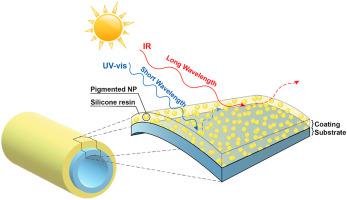Materials Today Energy ( IF 9.3 ) Pub Date : 2020-12-02 , DOI: 10.1016/j.mtener.2020.100609 X. Wang , E. Lee , C. Xu , J. Liu

|
Solar selective absorber coating with long-term thermal stability at high temperatures ≥750 °C in air is an important component to reduce the levelized cost of energy (LCOE) of concentrating solar power (CSP) systems toward 50% power efficiency and dispatchable solar electricity. Conventionally, solar spectral selectivity requires multilayer-interference coatings implemented by stringently controlled vacuum deposition, and these coatings degrade significantly at >700 °C in air. Herein, we established a quantitative design approach and demonstrated a proof-of-concept air-stable, manganese–iron oxide nanoparticle (NP)-pigmented solar selective coatings with a high solar absorptance of ~93%, a relatively low thermal emittance of ~52%, and an optical-to-thermal energy conversion efficiency >89% under 1,000× solar concentration at 750 °C toward Generation 3 CSP systems. These coatings demonstrate spectral selectivity using cost-effective spray coating approach, a notable improvement over conventional vacuum-deposited, multilayer solar selective coatings for low-cost, high-efficiency solar thermal receivers. In contrast to the thermal degradation of spectrally non-selective benchmark Pyromark 2500 coatings at 750 °C in air, the solar absorptance of the MnFe2O4-pigmented coatings on stainless steel 310 (SS 310) substrates is increased to ~92.9% and the optical-to-thermal energy conversion efficiency is improved to 89.7% after serving at 750 °C in air for 700 h. X-ray diffraction results reveal that this improvement is due to the transformation of MnFe2O4 NPs into more thermodynamically stable, non-stoichiometric manganese-rich manganese ferrite and iron-rich manganese–iron oxide phases after 500 h aging at 750 °C. For >1,000 h-endurance testing at 750 °C in air and the subsequent 19 day-night thermal cycling between 750 °C (12 h/cycle) and 25 °C (12 h/cycle) on SS 310 substrates, the thermal degradation is mainly due to the CrOx microflake formation from SS 310 substrates rather than the coatings, which can be suppressed by preoxidizing the surface of SS 310. With lower emittance matrix material and further optimization of pigment NP stoichiometry, concentration, and coating thickness, it is promising to achieve an optimized thermal efficiency ≥92.5% with long-term thermal stability at 750 °C for Generation 3 CSP systems.
中文翻译:

高效,空气稳定的锰-氧化铁纳米粒子着色的太阳能选择性吸收剂涂料,用于在750°C下运行的集中式太阳能发电系统
在空气中≥750°C的高温下具有长期热稳定性的太阳能选择性吸收剂涂层是将集中式太阳能(CSP)系统的平均能源成本(LCOE)降低至50%的能效和可调度太阳能的重要组成部分。常规地,太阳光谱选择性需要通过严格控制的真空沉积来实现的多层干涉涂层,并且这些涂层在空气中> 700°C时会明显降解。在本文中,我们建立了定量设计方法,并演示了概念验证的空气稳定的锰-氧化铁纳米颗粒(NP)着色的太阳能选择性涂层,具有约93%的高太阳吸收率,约〜较低的热发射率在1以下时,光热能转换效率为52%,> 89%第三代CSP系统在750°C下的000×太阳集中度。这些涂层使用经济高效的喷涂方法展示了光谱选择性,这是对低成本,高效率太阳能热接收器的常规真空沉积多层太阳能选择性涂层的显着改进。与光谱非选择性基准Pyromark 2500涂层在空气中750°C时的热降解相反,MnFe的太阳吸收率在750°C的空气中放置700小时后,不锈钢310(SS 310)基材上的2 O 4颜料涂层增加至〜92.9 %,光热能转换效率提高至89.7%。X射线衍射结果表明,这种改善是由于MnFe 2 O 4 NPs在750°C老化500 h后转变成热力学更稳定,非化学计量的富锰铁氧体和富铁锰铁氧化物相。 。为了在750°C的空气中进行> 1,000小时的耐久力测试,并随后在SS 310基板上进行750°C(12 h / cycle)和25°C(12 h / cycle)之间的随后19天夜间热循环,主要是由于CrO x 从SS 310基材而不是涂层形成微薄片,可以通过预氧化SS 310的表面来抑制。通过降低发射率基质材料以及进一步优化颜料NP的化学计量,浓度和涂层厚度,有望实现最佳的热性能。第三代CSP系统的效率≥92.5%,在750°C时具有长期热稳定性。



























 京公网安备 11010802027423号
京公网安备 11010802027423号